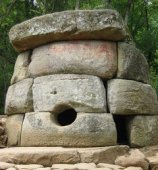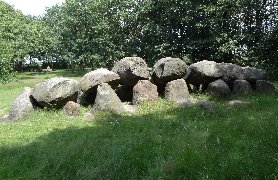
 In
various places from all over the world across the coasts of West Europe
- from Portugal to Denmark - and in France, Ireland, Scotland,
England, Sweden, the Netherlands, Russia (as seen on the image right
from
the northern Caucasus), Korea and the American north-east, there are
seemingly primitive constructions consisting of a single chamber and
build with enormous megalithic stones.
In
various places from all over the world across the coasts of West Europe
- from Portugal to Denmark - and in France, Ireland, Scotland,
England, Sweden, the Netherlands, Russia (as seen on the image right
from
the northern Caucasus), Korea and the American north-east, there are
seemingly primitive constructions consisting of a single chamber and
build with enormous megalithic stones.
Because there are some dolmens which are buried with earth, it is
generally accepted that these stones were used as a firm skeleton
that was buried with a thick layer of earth, and this forming a hill.
The entrance to the inside of this hill would be possible be closed by
a rolling stone or a heavy stone slab.
Archaeologists do not know for sure how people could have erected these stones, who build them and for what kind of reason, thus they came up with theories. The most widely accepted theory is that they are tombs, though at many places there haven't been found any human remains found inside these structures. Because of this, certain of these bunker-like dolmens may had been built to function as steady homes which offered protection against the cold, against roaming predators and to prevent the looting of the food supply, just like how ancient cavemen sought their retreat in caves. Most nearby found human remains seem to date from 4,000 to 3,000 BC, and the oldest nearby remains, which were found in Western Europe, were dated around 7,000 BC.
The "old religion" known as Paganism asserts that dolmens, stone circles, tree sanctuaries and menhirs were built in prehistoric times as spiritual centres at the intersection points of so-called "ley lines". (See the chapter: "Energy Lines of the Earth".) In later times, churches (whereof many of these date before the year 1350) had been built at many of these places. These places would hold a high etheric force in the Earth that could be used to improve the communication with the Divine. It is believed that these etheric forces would be even stronger on specific dates.
Ancient legends tell us that these stones were being moved to its place by levitation, caused by loud chanting and the concentrated minds of people who gathered in a closed circle around the stone. Could these structures have been built with the aid of ancient now forgotten knowledge and technology? Many of these stones look and feel rather unusually smooth with no sharp edges for a raw piece of stone, and sometimes the "ceiling" is made especially smooth. Dolmens often exist from large granite boulders. Granite is an igneous rock that often exists of three minerals: feldspars, micas and quartz. As research pointed out that the Bluestones from Stonehenge exist of diorite that holds tiny particles of quartz crystal, could it be that these stones also were once used for healing purposes?
 The
Netherlands has its own
variation of dolmens, known as "hunebedden", which are found the
regions of Drenthe, Groningen and Friesland. (The hunebed called "D18"
from Drenthe is seen on the left.) All these dolmens have their
entrances pointed
to the south. A certain number
of these dolmens have some smooth, round and undeep holes
that are known as "potmarks" that seem to be artificially created. It
is not known how these holes were formed or created and whether or
not they could have served a certain purpose.
The
Netherlands has its own
variation of dolmens, known as "hunebedden", which are found the
regions of Drenthe, Groningen and Friesland. (The hunebed called "D18"
from Drenthe is seen on the left.) All these dolmens have their
entrances pointed
to the south. A certain number
of these dolmens have some smooth, round and undeep holes
that are known as "potmarks" that seem to be artificially created. It
is not known how these holes were formed or created and whether or
not they could have served a certain purpose.
The name "Friesland" comes from "Frya's Land"; named
after the goddess Freyja, from Norse mythology. A copy of an
ancient document from Friesland states that its
inhabitants; the Frisians, once came from another land that was
struck by huge earthquakes and was ultimately swallowed by a great
flood, that was known as Aldland or Atland (possibly Atlantis). Based
upon this document there had been published a book in the year 1872
called: "Thet
Oera Linda Bok" (The Oera Linda Book), and exists of two
parts; The earliest portion of the book, called "Frya's Tex"
(Freyja's Law) was supposedly composed in 2194 BC, while the
other part, the letter of "Hidde Oera Linda" dates to 1256
CE. The text is fully readable online at:
http://www.sacred-texts.com/atl/olb
According
to a session of Dr. Douglas James Cottrell, the earliest dolmens were
erected some 35,000 years ago in Egypt (just after the
third destructive force in the world) and this habit has spread
from here to Europe where they are found the most in present day.
These dolmens originally would have served as a sort of markers for
travellers that sojourned on foot, that made it apparent that people
had been here before. It also was a reminder that "all are One",
and that one went in the direction towards civilization and
friendship. The round holes that would have created in some of these
stones would have been made to place certain precious stones or
jewels into it that would illuminate from the interaction with the
stone of the dolmen. Could it be that these dolmens were able to hold
a certain concentrated energetic, perhaps electric charge, like
a battery? (Source: "Rev.
Douglas James Cottrell PhD: The Baghdad Battery / Dolmen".)



